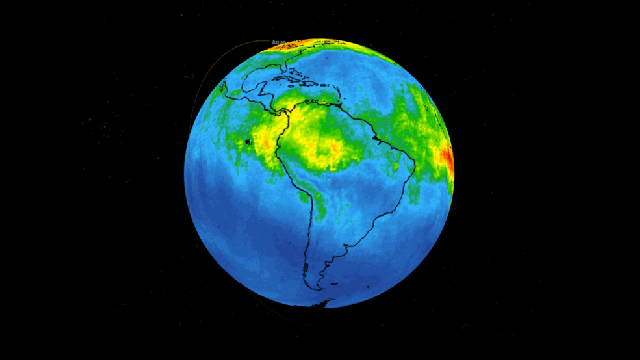New satellite imagery shows gigantic plumes of noxious carbon monoxide wafting over Brazil’s Amazon rainforest and surrounding areas — the result of massive forest fires currently raging in the region.
The new timelapse video was produced by NASA, and it shows the movement of carbon monoxide in the upper atmosphere above South America from August 8-22.
Data for the video was collected by the Atmospheric Infrared Sounder (AIRS) instrument on the Aqua satellite. AIRS, in conjunction with the Advanced Microwave Sounding Unit (AMSU), detects infrared and microwave radiation from Earth. That allows scientists to create 3-D maps of the Earth’s atmosphere, including elements such as temperature, humidity, cloud cover, greenhouse and trace gas concentrations, among other things.
These plumes of carbon monoxide are coming from the thousands of intentionally set forest fires currently raging in the Amazon rainforest — fires that have been linked to President Jair Bolsonaro’s efforts to weaken Brazil’s environmental laws and subsequent illegal land-clearing operations.
AIRS data shows the carbon monoxide at elevations reaching 5,500 metres. Looking at the video, the plumes first appear in the northwest region of the Amazon, and then drift both in a southerly and easterly direction — including a concentrated plume that travels towards Sao Paulo, home to 12.2 million people. The city saw the sky go dark at midday last week due, in part, to smoke from the blazes.
To create each frame in the video, NASA averaged the volume of carbon monoxide across three day increments. Red splotches show carbon monoxide at volumes reaching 160 parts per billion (ppb), while yellow shows 120 ppb and green 100 ppb. Local levels are likely “significantly higher,” according to NASA.
Carbon monoxide from wildfires can linger in the atmosphere for around a month. This gas won’t affect humans when it’s in the upper atmosphere, but strong winds will likely bring it closer to the surface where it will impact upon air quality and human health. An info sheet from the U.S. New York State Department of Health describes the effects of carbon monoxide:
Inhaling carbon monoxide decreases the body’s oxygen supply. This can cause headaches, reduce alertness, and aggravate a heart condition known as angina. Fine particles are able to travel deeply into the respiratory tract, reaching the lungs. Inhaling fine particles can cause a variety of health effects, including respiratory irritation and shortness of breath, and can worsen medical conditions such as asthma and heart disease.
During increased physical exertion, cardiovascular effects can be worsened by exposure to carbon monoxide and particulate matter. Once exposure stops, symptoms from inhaling carbon monoxide or fine particles generally diminish, but may last for a couple of days.
Carbon monoxide can also exacerbate the effects of climate change. Though technically not a greenhouse gas, carbon monoxide “affects the abundance of greenhouse gases such as methane and carbon dioxide,” according to NASA’s Earth Observatory. It also contributes to the formation of urban smog and unhealthy air.
The unprecedented forest fires in Brazil are proving to be an important wakeup call to the unjust and criminally irresponsible policies of President Bolsonaro, not to mention the downstream effects of such large scale fires. Our planet is one hot mess right now, and negligent politicians are making a bad situation considerably worse.
